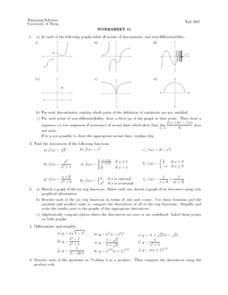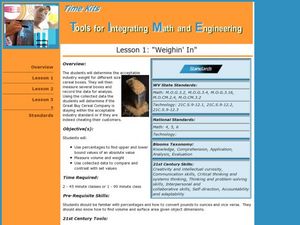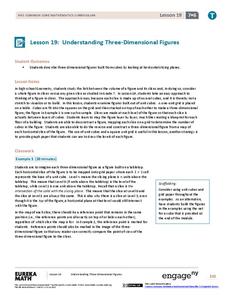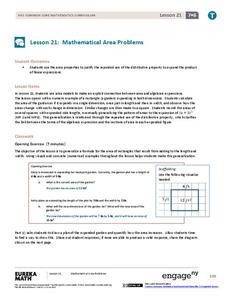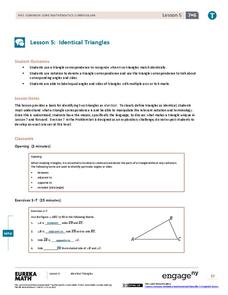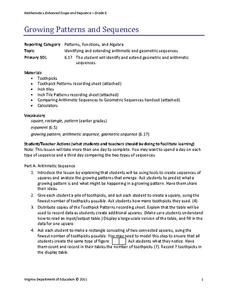Curated OER
Worksheet 1
In this math worksheet, pupils describe the difference between a partial and an ordinary differential equation. They give examples of 1st, 2nd, and 3rd order differential equations. Students apply this information to predator/prey...
Curated OER
Worksheet 11 - Points of Discontinuity
In this points of discontinuity worksheet, students observe graphs and label them as points of discontinuity and non-differentiability. They identify the derivatives of functions. This one-page worksheet contains five multi-step problems.
Curated OER
Worksheet 1
In this math worksheet, students give examples of functions that will satisfy given conditions. Students tell the tabulations for a given function. Students use the definition of a derivative to compute the inverse of a function. they...
Curated OER
Worksheet 24
For this math worksheet, students work with three dimensional graphing. The application problems include surface ships on maneuvers determining a submarine's course, helicopter travel, and proving that four points are coplanar. Students...
Curated OER
Worksheet 10: Continuous Functions
In this math worksheet, students answer 7 questions regarding continuous functions, domains, differentiables, and inverse functions.
Curated OER
Worksheet 17-Fall 1995
In this math worksheet, pupils find y' both implicitly and explicitly for given relations. They find y' using implicit differentiation for a given relation. Students prove the Pythagorean Theorem
Curated OER
Arithmetic Sequences
Find the sequence of an equation with your math super stars. They differentiate between arithmetic and geometric sequences and then calculate the sum of finite and infinite sequences.
Curated OER
Worksheet 31 - Doman & Range
In this function worksheet, students determine the domain and range of given functions. They use trigonometric ratios to determine if a statement is true or false. Students differentiate equations. In this one-page worksheet, students...
Curated OER
Math Averages
Students perform different activities to better explain that the word "Average" has 5 different meanings.
Curated OER
Tools for Integrating Math and Engineering: Weighin' In
Learners collect and analyze data on a fictional cereal company's products. In this measurement lesson, students collect data from cereal boxes (weight, volume, surface area, etc.) to determine if the boxes labels correctly inform...
Curated OER
Decimals Decide Olympic Champions
The class discovers how a decimal can make all the difference in the Olympics. As they learn about decimal place values, they compare and contrast data and demonstrate decimal values using manipulatives.
EngageNY
Newton’s Law of Cooling, Revisited
Does Newton's Law of Cooling have anything to do with apples? Scholars apply Newton's Law of Cooling to solve problems in the 29th installment of a 35-part module. Now that they have knowledge of logarithms, they can determine the decay...
EngageNY
Surface Area II
Examine the surface area of composite figures using an exploratory approach. As a continuation of the previous lesson plan of the 29-part series, young scholars develop plans for finding the surface area of composite figures. Examples...
EngageNY
Understanding Three-Dimensional Figures
You can't judge a book by its cover ... or a cube structure by just one face. A creative activity looks at the shape of several cube structures described by level slices. The 20th activity of the 29-part series expects young...
EngageNY
Mathematical Area Problems
Teach the connection between area models and the distributive property through problem-solving. The 22nd activity in a series of 29 explains the distributive property graphically. Learners build area models from word problems and convert...
EngageNY
Slicing a Right Rectangular Pyramid with a Plane
How many ways can you slice a pyramid? The 18th lesson of the 29-part series examines the multiple planes of a rectangular pyramid. Pupils study each slice to determine its shape and relation to the different faces.
EngageNY
Identical Triangles
Explore vocabulary and notation related to triangles and congruence. The fifth lesson in the 29-part series helps pupils build their knowledge of triangle relationships. Individuals identify corresponding parts of identical triangles and...
EngageNY
Collecting Rational Number Like Terms
Teach pupils to handle fractions fluently. The sixth installment in the series of 28 has class members apply the concepts learned in previous lessons to expressions with fractional coefficients. The fractions are both mixed numbers and...
EngageNY
Complementary and Supplementary Angles
Connect algebraic and geometric concepts to solve problems. The first instructional activity in the 29-part series examines complementary and supplementary angle relationships. Scholars write equations to represent the relationships and...
EngageNY
Solving Inequalities
Investigate complex problem situations by applying inequalities. Building from concepts explored in the previous lesson plan, learners read word problems and develop inequalities to represent the situation. They then solve the...
EngageNY
Angle Problems and Solving Equations II
Demonstrate the application of algebra to geometric angle relationships with an activity that asks learners to use what they know about adjacent and vertical angles to write algebraic equations. Diagrams become more complex in this...
EngageNY
Generating Equivalent Expressions II
Discover how to apply the commutative and associative properties to generate equivalent expressions. The second lesson in the 28-part module asks pupils to rearrange an expression by grouping like terms. From there, they can combine...
Virginia Department of Education
Growing Patterns and Sequences
Learners explore, discover, compare, and contrast arithmetic and geometric sequences in this collaborative, hands-on activity. They build and analyze growing patterns to distinguish which kind of sequence is represented by a set of data...
Virginia Department of Education
Adding and Subtracting Fractions
Your learners will enjoy playing a game as a motivator to learning and remembering the adding and subtracting of fractions.

